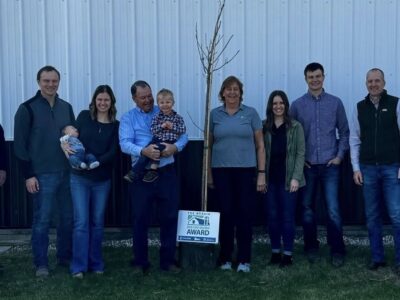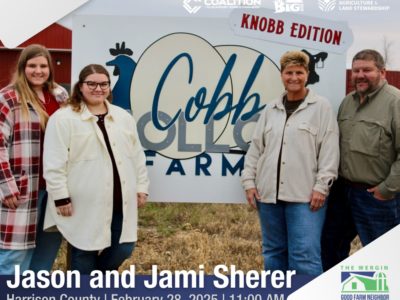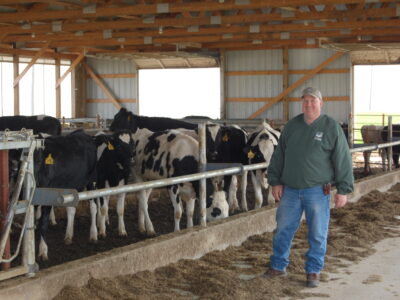Going Green
06-26-2019 in Article
WEST DES MOINES, IOWA – June 25, 2019 – More than 70,000 trees have been planted under the Coalition to Support Iowa’s Farmers’ Green Farmstead Partner Program since 2009 when CSIF joined forces with Trees Forever and the Iowa Nursery Landscape Association to encourage farmers to plant windbreaks near their livestock facilities.
“First of all, a windbreak is important as a visual barrier,” says Waddingham. “Neighbors can look out and see trees rather than a building.” Neighbor relations are an important service of CSIF. “Trees and shrubs say the farmer is committed to the environment, above and beyond what is required. It says the producer takes pride in his farm and his livestock.”
A vegetative buffer also offers real benefits in the form of energy cost savings, odor control, weather protection, improved building ventilation and in some cases, even provides an additional revenue stream.
“There are many opportunities out there to improve the environment and your livestock site,” says Waddingham.
From refurbishing an old grove to planting a new windbreak, the program enlists the aid of 26 nursery professionals across the state trained to work with livestock facilities. So far, more than 200 farms have benefited from the program.
Growing benefits
Iowa State University research shows trees near a livestock site can reduce odor by 10-15 percent by capturing dust and odor particles and directing airflow. Both conifer and deciduous trees can help with odor control. A traditional multi-row windbreak design is comprised of three or more rows of vegetation, at least one of which is densely planted conifers.
A properly planted windbreak of trees and shrubs can also help control energy costs, reducing heating and cooling expense for the livestock unit by providing shade and directing air flow.
A windbreak can reduce snow removal time and expense by channeling snow into desired areas, keeping it out of feedbunks and driveways and clear of ventilation fans. Shrubs offer ground level protection from blowing snow and increase the windbreak’s role in providing wildlife habitat.
Adding native prairie grasses and forbs will further enhance wildlife habitat. Bees and butterflies are necessary for plant pollination, and their natural environment is shrinking as humans alter the landscape. Brad Riphagen of Trees Forever says producers should think outside the box to incorporate pollinator habitat into their windbreaks.
“Area pollinators depend on a variety of plant colors and smells to do their job, and farmers have a unique opportunity to incorporate those plants,” says Riphagen.
For some, making a windbreak part of the farm’s sustainability plan involves utilizing agroforestry species in the design. A variety of nuts have market potential. Walnuts, pecans, Chinese chestnuts, and hazelnuts are popular species for the area. There are also markets for woody decorative florals such as pussy willows and holly or other floral greens.
Berries, like the popular aronia berries, are gaining steam as a super food; elderberries can yield farm income once established; and classic fruit trees or Christmas trees are always an option.
Specialty forest products can take years to establish and are best grown on a small scale, making them a perfect fit as part of a livestock facility windbreak.
Cost share assistance
Both the Environmental Quality Assistance Program (EQIP) and the Conservation Stewardship Program (CSP) through the Natural Resources Conservation Service provide financial assistance.
EQIP provides financial assistance to producers who address priority resource concerns. Windbreaks and shelterbelt establishment fall under that definition. Financial assistance can be available for plants, labor, equipment and supporting materials.
CSP funds come with the same eligibility requirements as EQIP and work to reward producers for existing stewardship as well as encourage new practices. Windbreak renovation or enhancing a hedgerow for wildlife habitat qualify, as do timber stand improvements.
Funding is also available through the Division of Soil Conservation and Water Quality Resource Enhancement and Protection (REAP) program. Each of the state’s 100 Soil and Water Conservation Districts is allocated $5,000-$10,000 annually and windbreaks are eligible projects.
CSIF covers the cost of the initial consultation and plan design when using a participating nursery. CSIF staff can also explain the various cost-share options that are available and if one of them is right for your farm. “It’s always a good idea to give CSIF a call and see what cost-share programs are available as they do change and new programs come along that may be a good fit for establishing a windbreak on your livestock farm,” says Waddingham.
Start with the right plan
“It’s important to get the right plant in the right place for the right purpose,” says Riphagen, citing the reason to consult the Green Farmstead Partner Program professionals. A well-built windbreak will protect the site from fierce north winter winds and maintain proper spacing for building ventilation and grounds maintenance.
Fast-growing Austree hybrid willows are popular, inexpensive, and well suited to Iowa’s climate, making them perfect for creating a visual screen. Conifers such as red spruce and Norway pines add a barrier against snow and wind. Popular shrubs used in Midwest windbreaks include Arrowwood Viburnum and several varieties of Dogwood that add color and aesthetic appeal.
Pumpkins, squash, watermelons, even milkweed can make for good pollinator-friendly options, as well as a variety of flowers and native prairie grasses that provide welcoming flowers and ground nesting opportunities.
“Large or small, Iowa’s farmers want to be good neighbors,” says CSIF Assistant Field Specialist Gabrielle Glenister. “They want to be proactive in enhancing the environment and their communities, and they want to make responsible use of their resources. The Green Farmstead Partner Program helps them do all those things. Give us a call, and we will set you up with a professional in your area who is trained on the best options for livestock farmers.”
More information on the Green Farmstead Partner Program can be found on the Coalition to Support Iowa’s Farmers website www.supportfarmers.com
The Coalition to Support Iowa’s Farmers was created by farmers to help farmers raise livestock successfully and responsibly. It’s a partnership involving the Iowa Beef Industry Council, Iowa Cattlemen’s Association, Iowa Corn Growers Association, Iowa Farm Bureau Federation, Iowa Pork Producers Association, Iowa Poultry Association, Iowa Soybean Association, Iowa Turkey Federation and Midwest Dairy Association. The non-profit, non-partisan organization aids farmers at no cost. CSIF does not lobby or develop policy. Farm families wanting a helping hand can contact the coalition at 1-800-932-2436.
(By Terri Queck-Matzie for CSIF. Queck-Matzie is a freelance writer from Greenfield).
-30-
Recommended News

Des Moines County crop and livestock farmers are leaders in their community and Iowa agriculture
Iowa Secretary of Agriculture Mike Naig will present the Wergin Good Farm Neighbor Award to the Dan and Jan Keitzer family of Des Moines County on Friday, April 11. The...
Read More
Harrison County poultry producers are leaders in their community
Iowa Secretary of Agriculture Mike Naig will present the Wergin Good Farm Neighbor Award to the Jason and Jami Sherer family of Harrison County on Friday, Feb. 28. The presentation...
Read More
Naig, Mowrer Named Honorary Master Pork Producers
The Coalition to Support Iowa’s Farmers (CSIF) today launched the Building Your Livestock Legacy Program, a self-guided, online mentorship initiative designed to connect aspiring livestock farmers with essential financial resources...
Read More